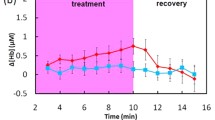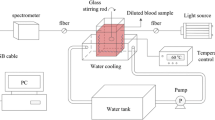Abstract
In this study, we investigate the efficiency of laser radiation on oxyhemoglobin (HbO2) rate in blood vessels and its wavelength dependence. The results of in vivo experimental measurements of the laser-induced photodissociation of HbO2 in cutaneous blood vessels in the visible and near-infrared (IR) spectral range are presented. Arterial oxygen saturation (SpO2) was measured by a method of fingertip pulse oximetry, which is based on the measurement of the modulated pulse wave of the blood. The light irradiating the finger was provided by corresponding light-emitting diodes (LED) at 15 wavelengths in the 400–940 nm spectrum range. Statistical results with a value of p < 0.05 were viewed as being significant for all volunteers. The results show that there is a decrease in SpO2 in the blood under the influence of the transcutaneous laser irradiation. Three maxima in the spectral range (530, 600, and 850 nm) are revealed, wherein decrease in the relative concentration of SpO2 reaches 5 % ± 0.5 %. Near-IR radiation plays a dominant role in absorption of laser radiation by oxyhemoglobin in deeper layers of tissue blood vessels. The obtained data correlate with the processes of light propagation in biological tissue. The observed reduction in SpO2 indicates the process of photodissociation of HbO2 in vivo and may result in local increase in O2 in the tissue. Such laser-induced enrichment of tissue oxygenation can be used in phototherapy of pathologies, where the elimination of local tissue hypoxia is critical.



Similar content being viewed by others
References
Gibson Q, Ainsworth S (1957) Photosensitivity of haem compounds. Nature 180:1416–1417
Saffran W, Gibson Q (1977) Photodissociation of ligands from heme and heme proteins. J Biol Chem 252:7955–7962
Yang N, Zhang S et al (2007) Photo-dissociation quantum yields of mammalian oxyhemoglobin investigated by a nanosecond laser technique. Biochem Biophys Res Commun 353:953–959
Valat P, Alpert B (1985) Quantum yield of thirty picosecond oxyhemoglobin photodissociation effect of protein fluctuations on the quantum yield values. Laser Chem 5:173–183
Yabushita I, Kobayashi T (2010) Primary events in the photodissociation of oxyhemoglobin. Spectroscopy 24:333–338
Yabushita A, Kobayashi T (2010) Ultrafast spectroscopy of oxyhemoglobin during photodissociation. J Phys Chem B 114:11654–11658
Ghelichkhani E, Goldbeck R, Lewis J (1996) Nanosecond time-resolved absorption studies of human oxyhemoglobin photolysis intermediates. Biophys J 71:1596–1604
Hoffman B, Gibson Q (1978) On the photosensitivity of liganded hemoproteins and their metal-substituted analogues. Proc Natl Acad Sci U S A 75:21–25
Traylor T, Berzinis A (1980) Binding of O2 and CO to hemes and hemoproteins. Proc Natl Acad Sci USA 77:3171–3175
Rovira C, Kunc K, Hutter J, Ballone P (1997) Equilibrium geometries and electronic structure of iron-porphyrin complexes: a density functional study. J Phys Chem A 101:8914–8925
Jensen P, Ryde U (2004) How O2 binds to heme. J Biol Chem 279:14561–14569
Petrich J, Poyart C, Martin J (1988) Photophysics and reactivity of heme proteins: a femtosecond absorption study of hemoglobin, myoglobin and protoheme. Biochemistry 27:4049–4060
Prahl S (1999) Optical absorption of hemoglobin. Oregon Medical Laser Center USA. http://omlc.org/spectra/hemoglobin/
Filho I, Terner J et al (2008) Measurement of hemoglobin oxygen saturation using Raman microspectroscopy and 532-nm excitation. J Appl Physiol 104:1809–1817
Sato H, Wada S et al (2000) Measurement of oxygenation of hemoglobin by direct transmission of near-infrared energy (700–1000 nm) from an electronically tuned Ti:sapphire laser. Appl Spectrosc 54:1163–1167
Asimov M, Korolevich A, Konstantinova E (2007) Kinetics of oxygenation of skin tissue exposed to low-intensity laser radiation. J Appl Spectrosc 74:133–139
Heu F, Forster C, Namer B, Dragu A (2013) Effect of low-level laser therapy on blood flow and oxygen hemoglobin saturation of the foot skin in healthy subjects. Laser Ther 22:21–30
Asimov M, Thanh N (2011) Laser-induced photodissociation of oxyhemoglobin: optical method of elimination of hypoxia. Opt Spectrosc 111:254–259
Liu P, Zhu Z et al (2012) Specific absorption spectra of hemoglobin at different PO2 levels: potential noninvasive method to detect PO2 in tissues. J Biomed Optics 17:125002
Lepeshkevich S et al (2013) Does photodissociation of molecular oxygen from myoglobin and hemoglobin yield singlet oxygen. J Photochem Photobiol B 120:130–141
Lisenko S, Kugeiko M (2015) Method for estimating optimal spectral and energy parameters of laser irradiation in photodynamic therapy of biological tissue. Quantum electron 45:359–365
Acknowledgment
This work is partially supported by the project DFNI B02/9/2014 of Bulgarian Science Fund.
Author information
Authors and Affiliations
Corresponding author
Ethics declarations
Compliance with ethical standards
All procedures performed in the study were in accordance with the ethical standards with informed consent obtained from each subject and approval by the institutional review board (Institute of Applied Problems of Physics and Biophysics, Academy of Sciences of Ukraine).
Conflict of interest
The authors declare that they have no competing interests.
Rights and permissions
About this article
Cite this article
Yesman, S.S., Mamilov, S.O., Veligotsky, D.V. et al. Local changes in arterial oxygen saturation induced by visible and near-infrared light radiation. Lasers Med Sci 31, 145–149 (2016). https://doi.org/10.1007/s10103-015-1838-y
Received:
Accepted:
Published:
Issue Date:
DOI: https://doi.org/10.1007/s10103-015-1838-y




